Performance Analysis of Ferronickel Slag-Ordinary Portland Cement Pervious Concrete
Abstract
:1. Introduction
2. Materials and Testing
2.1. Raw Materials
2.2. Mix Proportions
2.3. Preparation of Test Blocks
2.4. Testing Method
2.4.1. Porosity and Density
2.4.2. Compressive Strength
2.4.3. Permeability Coefficient
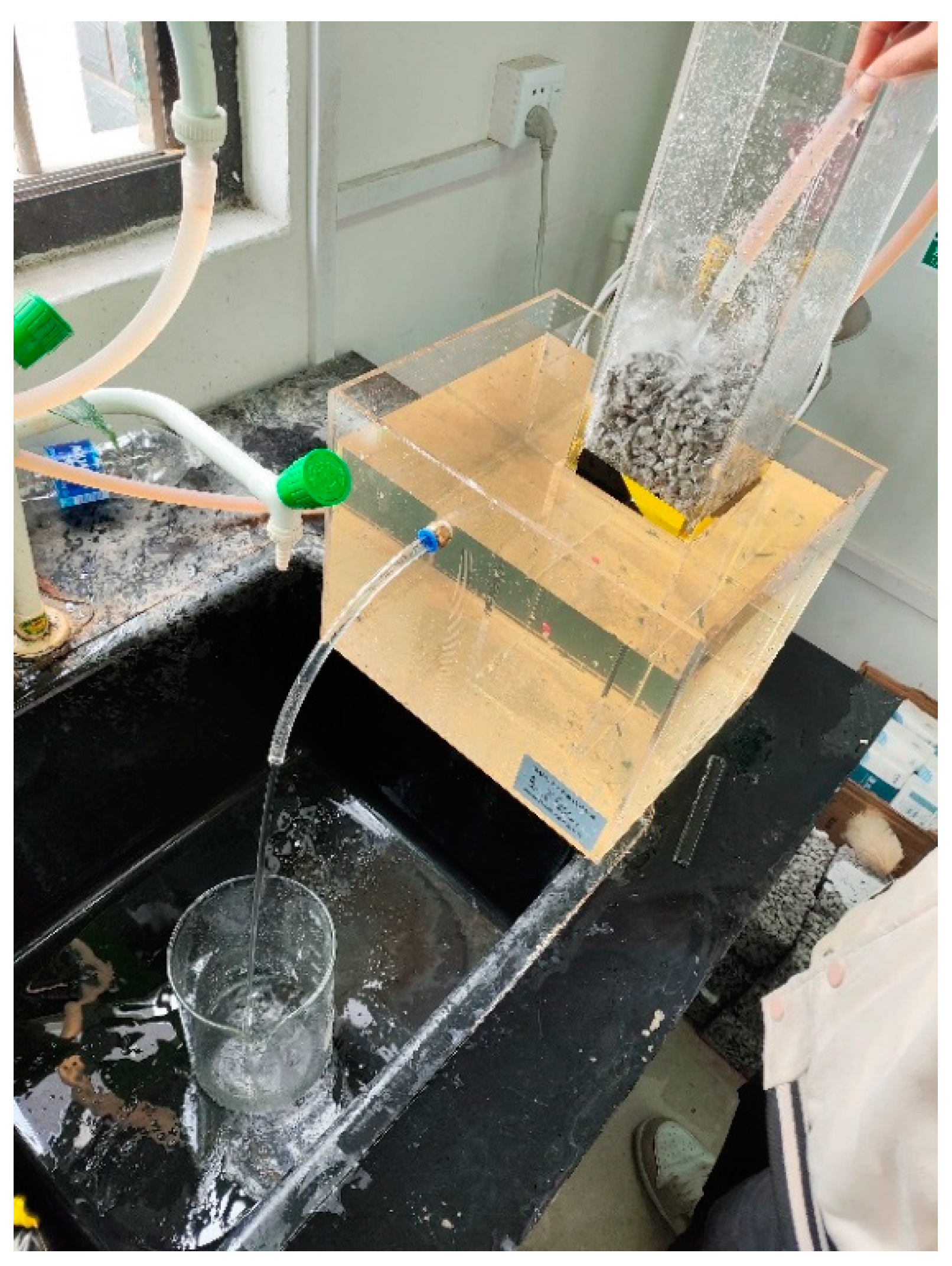
3. Results and Discussion
3.1. Porosity and Density
3.2. Strength Test of FOPM
3.3. Strength of FOPC
3.4. Permeability Performance
4. Conclusions
- (1)
- The chemical composition and particle dimensions of FNS align with those of mineral admixtures like Metakaolin, mainly containing CaO, SiO2, Al2O3, MgO and other substances, and after grinding into powder, the particle size distribution of FNS is within the range of 0.5 to 100 μm.
- (2)
- As the replacement rate of FNS increases, the strength of FOPM does not decrease proportionally, which also indicates that FNS plays a strength contribution role in cementitious materials.
- (3)
- The presence of FOPM plays a crucial role in determining the strength of FOPC, and when the strength of FOPM and the ratio of cementitious to aggregate increases, both can improve the strength of FOPC. When the ratio of cementitious to aggregate increased by 6.7% and 16.5%, the strength of FOPC increased by 10–13% and 30–50%, respectively.
- (4)
- The ratio of cementitious to aggregates markedly impacts the permeability coefficient. This is because the ratio of FOPM to aggregate has a significant impact on porosity, which indirectly affects the permeability coefficient, and the FOPC’s permeability coefficient increases with porosity, predominantly exhibiting a linear progression, albeit with some inconsistencies. In design, porosity can be controlled to control the permeability coefficient.
- (5)
- FOPC has excellent performance in terms of permeability, and its strength is lower than that of ordinary pervious concrete. Therefore, FOPC can be used on some road surfaces with lower strength requirements. In addition, due to its high porosity, FOPC can also be attempted for use in vegetation concrete. Due to the certain activity of FNS, future work will also attempt to stimulate its activity through alkali to obtain better performance cementitious materials.
Author Contributions
Funding
Institutional Review Board Statement
Informed Consent Statement
Data Availability Statement
Conflicts of Interest
References
- Adresi, M.; Yamani, A.; Karimaei Tabarestani, M.; Rooholamini, H. A Comprehensive Review on Pervious Concrete. Constr. Build. Mater. 2023, 407, 133308. [Google Scholar] [CrossRef]
- Lima, G.T.D.S.; Rocha, J.C.; Cheriaf, M. Investigation of the Properties of Pervious Concrete with a Recycled Aggregate Designed with a New Combination of Admixture. Constr. Build. Mater. 2022, 340, 127710. [Google Scholar] [CrossRef]
- Bright Singh, S.; Murugan, M. Effect of Metakaolin on the Properties of Pervious Concrete. Constr. Build. Mater. 2022, 346, 128476. [Google Scholar] [CrossRef]
- Pradhan, S.K.; Behera, N. Performance Assessment of Pervious Concrete Road on Strength and Permeability by Using Silica Fume. Mater. Today Proc. 2022, 60, 559–568. [Google Scholar] [CrossRef]
- Zheng, X.; Pan, J.; Easa, S.; Fu, T.; Liu, H.; Liu, W.; Qiu, R. Utilization of Copper Slag Waste in Alkali-Activated Metakaolin Pervious Concrete. J. Build. Eng. 2023, 76, 107246. [Google Scholar] [CrossRef]
- Wu, S.; Wu, Q.; Shan, J.; Cai, X.; Su, X.; Sun, X. Effect of Morphological Characteristics of Aggregate on the Performance of Pervious Concrete. Constr. Build. Mater. 2023, 367, 130219. [Google Scholar] [CrossRef]
- Teymouri, E.; Wong, K.S.; Tan, Y.Y.; Pauzi, N.N.M. Mechanical Behaviour of Adsorbent Pervious Concrete Using Iron Slag and Zeolite as Coarse Aggregates. Constr. Build. Mater. 2023, 388, 131720. [Google Scholar] [CrossRef]
- Tang, B.; Fan, M.; Yang, Z.; Sun, Y.; Yuan, L. A Comparison Study of Aggregate Carbonation and Concrete Carbonation for the Enhancement of Recycled Aggregate Pervious Concrete. Constr. Build. Mater. 2023, 371, 130797. [Google Scholar] [CrossRef]
- Nazeer, M.; Kapoor, K.; Singh, S.P. Strength, Durability and Microstructural Investigations on Pervious Concrete Made with Fly Ash and Silica Fume as Supplementary Cementitious Materials. J. Build. Eng. 2023, 69, 106275. [Google Scholar] [CrossRef]
- Alex, A.G.; Jose, P.A.; Saberian, M.; Li, J. Green Pervious Concrete Containing Diatomaceous Earth as Supplementary Cementitous Materials for Pavement Applications. Materials 2022, 16, 48. [Google Scholar] [CrossRef]
- Gao, S.; Huang, K.; Chu, W.; Wang, W. Feasibility Study of Pervious Concrete with Ceramsite as Aggregate Considering Mechanical Properties, Permeability, and Durability. Materials 2023, 16, 5127. [Google Scholar] [CrossRef] [PubMed]
- Mitrosz, O.; Kurpińska, M.; Miśkiewicz, M.; Brzozowski, T.; Abdelgader, H.S. Influence of the Addition of Recycled Aggregates and Polymer Fibers on the Properties of Pervious Concrete. Materials 2023, 16, 5222. [Google Scholar] [CrossRef] [PubMed]
- Park, J.-H.; Jeong, S.-T.; Bui, Q.-T.; Yang, I.-H. Strength and Permeability Properties of Pervious Concrete Containing Coal Bottom Ash Aggregates. Materials 2022, 15, 7847. [Google Scholar] [CrossRef] [PubMed]
- Anwar, F.H.; El-Hassan, H.; Hamouda, M.; Hinge, G.; Mo, K.H. Meta-Analysis of the Performance of Pervious Concrete with Cement and Aggregate Replacements. Buildings 2022, 12, 461. [Google Scholar] [CrossRef]
- Martins Filho, S.T.; Pieralisi, R.; Lofrano, F.C. Framework to Characterize Nonlinear Flow through Pervious Concrete. Cem. Concr. Res. 2022, 151, 106633. [Google Scholar] [CrossRef]
- Sun, J.; Feng, J.; Chen, Z. Effect of Ferronickel Slag as Fine Aggregate on Properties of Concrete. Constr. Build. Mater. 2019, 206, 201–209. [Google Scholar] [CrossRef]
- Bao, J.; Yu, Z.; Wang, L.; Zhang, P.; Wan, X.; Gao, S.; Zhao, T. Application of Ferronickel Slag as Fine Aggregate in Recycled Aggregate Concrete and the Effects on Transport Properties. J. Clean. Prod. 2021, 304, 127149. [Google Scholar] [CrossRef]
- Kim, H.; Lee, C.H.; Ann, K.Y. Feasibility of Ferronickel Slag Powder for Cementitious Binder in Concrete Mix. Constr. Build. Mater. 2019, 207, 693–705. [Google Scholar] [CrossRef]
- Saha, A.K. Sustainable Use of Ferronickel Slag Fine Aggregate and Fly Ash in Structural Concrete: Mechanical Properties and Leaching Study. J. Clean. Prod. 2017, 162, 438–448. [Google Scholar] [CrossRef]
- Nguyen, Q.D.; Castel, A.; Kim, T.; Khan, M.S.H. Performance of Fly Ash Concrete with Ferronickel Slag Fine Aggregate against Alkali-Silica Reaction and Chloride Diffusion. Cem. Concr. Res. 2021, 139, 106265. [Google Scholar] [CrossRef]
- Nguyen, Q.D.; Khan, M.S.H.; Castel, A.; Kim, T. Durability and Microstructure Properties of Low-Carbon Concrete Incorporating Ferronickel Slag Sand and Fly Ash. J. Mater. Civ. Eng. 2019, 31, 04019152. [Google Scholar] [CrossRef]
- Nuruzzaman, M.; Kuri, J.C.; Sarker, P.K. Strength, Permeability and Microstructure of Self-Compacting Concrete with the Dual Use of Ferronickel Slag as Fine Aggregate and Supplementary Binder. Constr. Build. Mater. 2022, 318, 125927. [Google Scholar] [CrossRef]
- JTG E42-2005; Test Method of Aggregate for Highway Engineering. Ministry of Communications of the PRC: Beijing, China, 2005. (In Chinese)
- Wang, D.; Wang, Q.; Zhuang, S.; Yang, J. Evaluation of Alkali-Activated Blast Furnace Ferronickel Slag as a Cementitious Material: Reaction Mechanism, Engineering Properties and Leaching Behaviors. Constr. Build. Mater. 2018, 188, 860–873. [Google Scholar] [CrossRef]
- Chi, L.; Lu, S.; Li, Z.; Huang, C.; Jiang, H.; Peng, B. Recycling of Ferronickel Slag Tailing in Cementitious Materials: Activation and Performance. Sci. Total Environ. 2023, 861, 160706. [Google Scholar] [CrossRef] [PubMed]
- Zhou, Y.; Shi, C. Experimental Study of Electric Furnace Ferronickel Slag as a Supplementary Cementitious Material in Massive High-Strength Concrete. J. Therm. Anal. Calorim. 2022, 147, 4983–4993. [Google Scholar] [CrossRef]
- Zhai, M.; Zhu, H.; Liang, G.; Wu, Q.; Zhang, C.; Hua, S.; Zhang, Z. Enhancing the Recyclability of Air-Cooled High-Magnesium Ferronickel Slag in Cement-Based Materials: A Study of Assessing Soundness through Modifying Method. Constr. Build. Mater. 2020, 261, 120523. [Google Scholar] [CrossRef]
- Chen, Y.; Ji, T.; Yang, Z.; Zhan, W.; Zhang, Y. Sustainable Use of Ferronickel Slag in Cementitious Composites and the Effect on Chloride Penetration Resistance. Constr. Build. Mater. 2020, 240, 117969. [Google Scholar] [CrossRef]
- JGJ/T70-2009; Standard for Test Method of Basic Properties of Construction Mortar. Ministry of Housing and Urban-Rural Development: Beijing, China, 2009. (In Chinese)
- CJJ/T135-2009; Technical Specification for Pervious Cement Concrete Pavement. Ministry of Housing and Urban-Rural Development: Beijing, China, 2009. (In Chinese)
- Furkan Ozel, B.; Sakallı, Ş.; Şahin, Y. The Effects of Aggregate and Fiber Characteristics on the Properties of Pervious Concrete. Constr. Build. Mater. 2022, 356, 129294. [Google Scholar] [CrossRef]
- Yan, X.; Wang, X.; Sun, C.; Xin, M.; He, J. Performance Analysis and Admixture Optimization of GBFS-HPMC/Fiber Pervious Concrete. Materials 2023, 16, 6455. [Google Scholar] [CrossRef]
- Li, H.; Yang, J.; Yu, X.; Zhang, Y.; Zhang, L. Permeability Prediction of Pervious Concrete Based on Mix Proportions and Pore Characteristics. Constr. Build. Mater. 2023, 395, 132247. [Google Scholar] [CrossRef]
- Yang, L.; Kou, S.; Song, X.; Lu, M.; Wang, Q. Analysis of Properties of Pervious Concrete Prepared with Difference Paste-Coated Recycled Aggregate. Constr. Build. Mater. 2021, 269, 121244. [Google Scholar] [CrossRef]
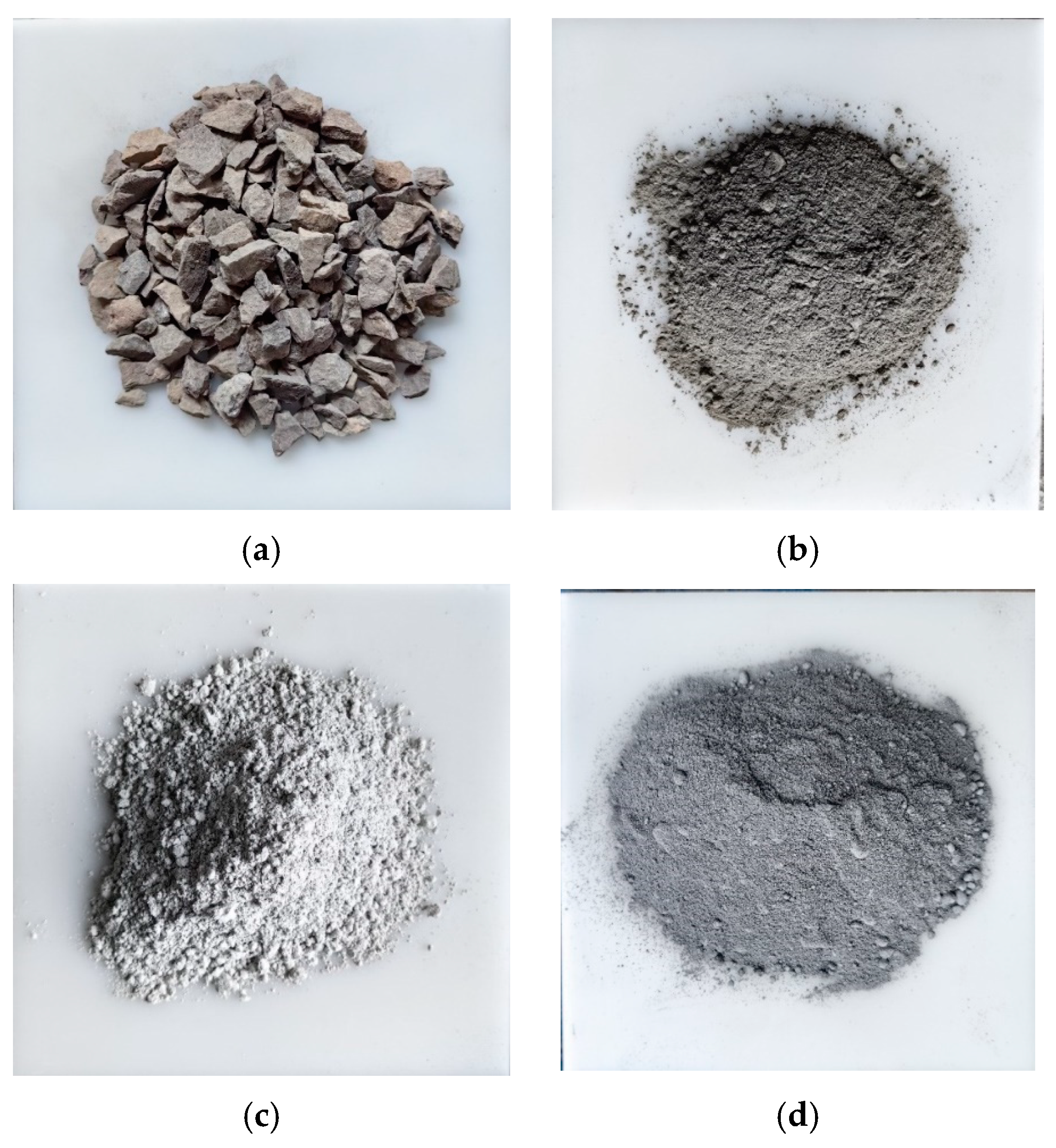



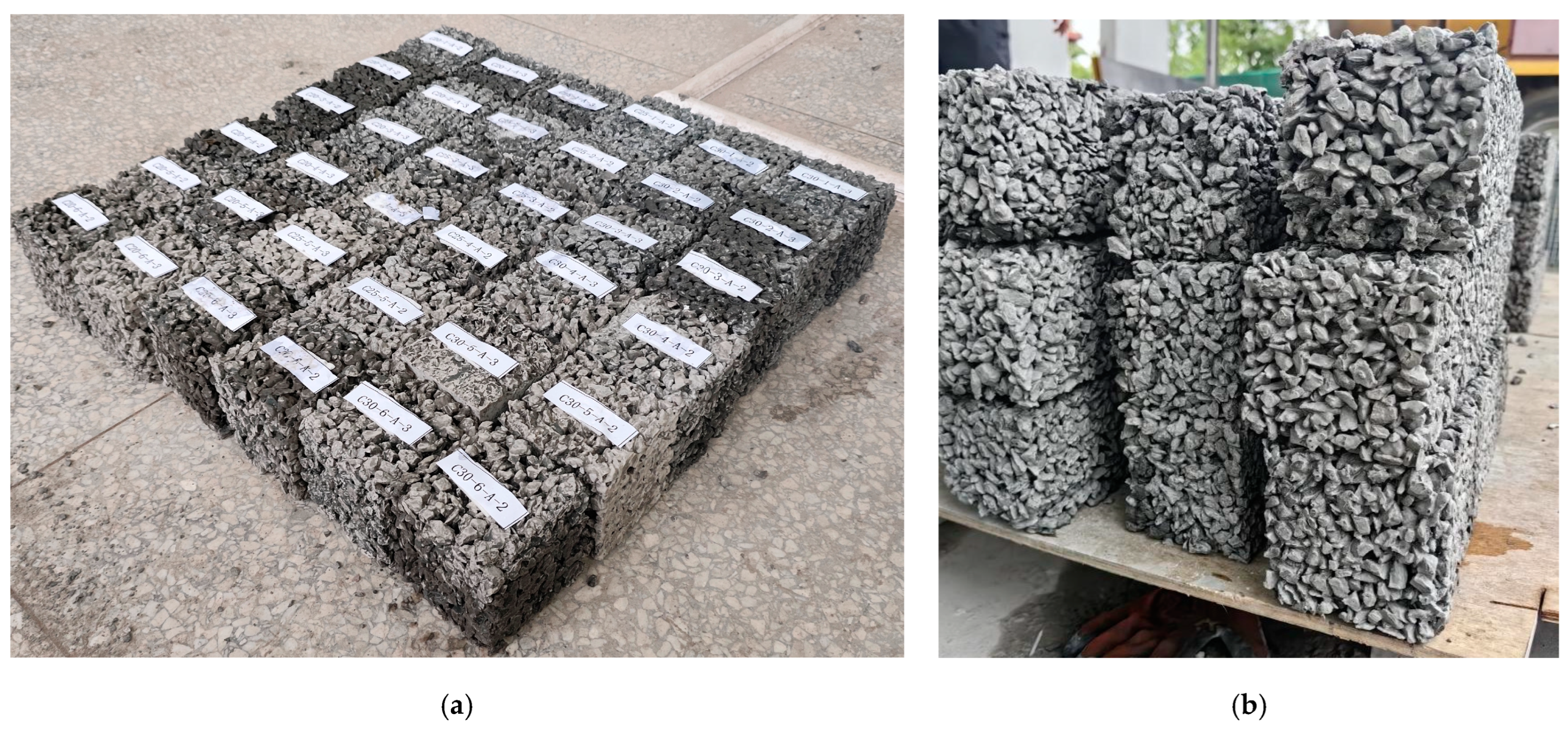
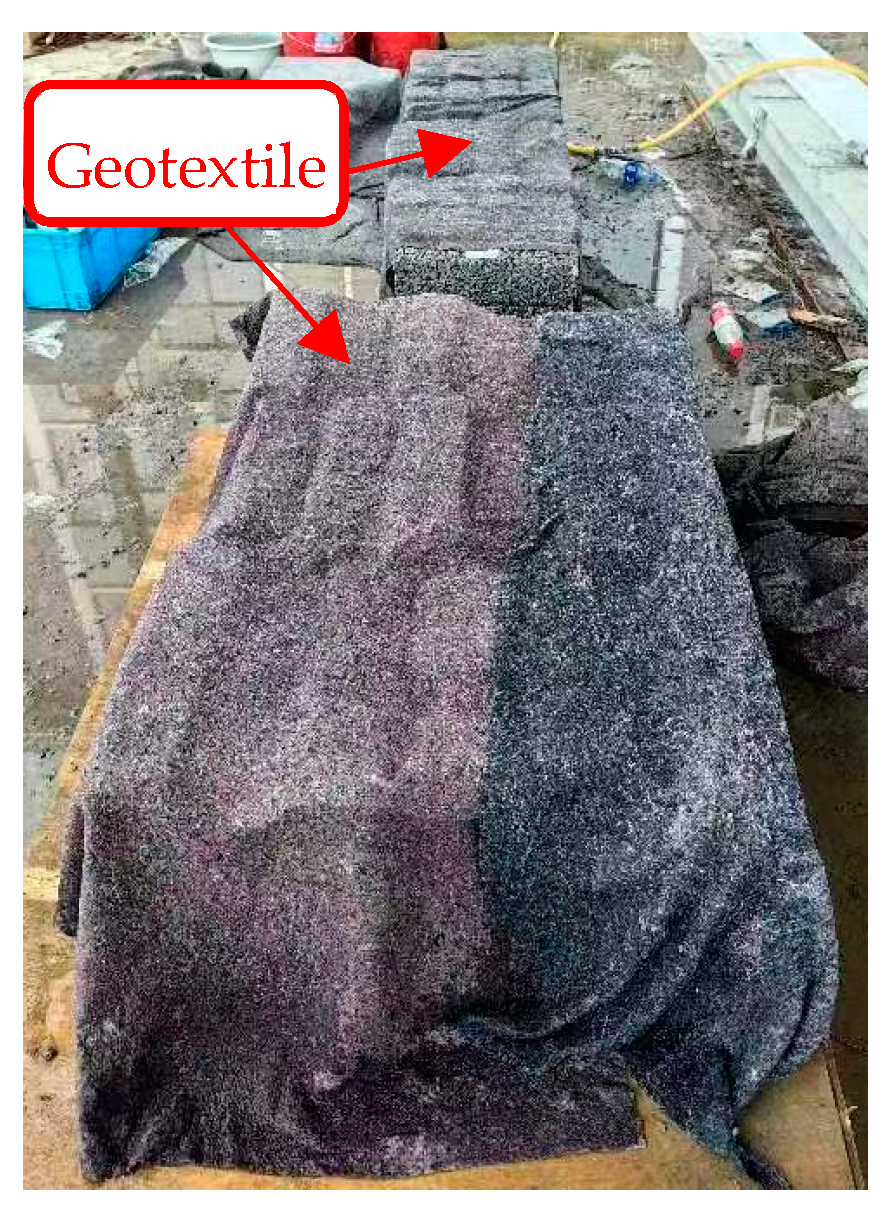
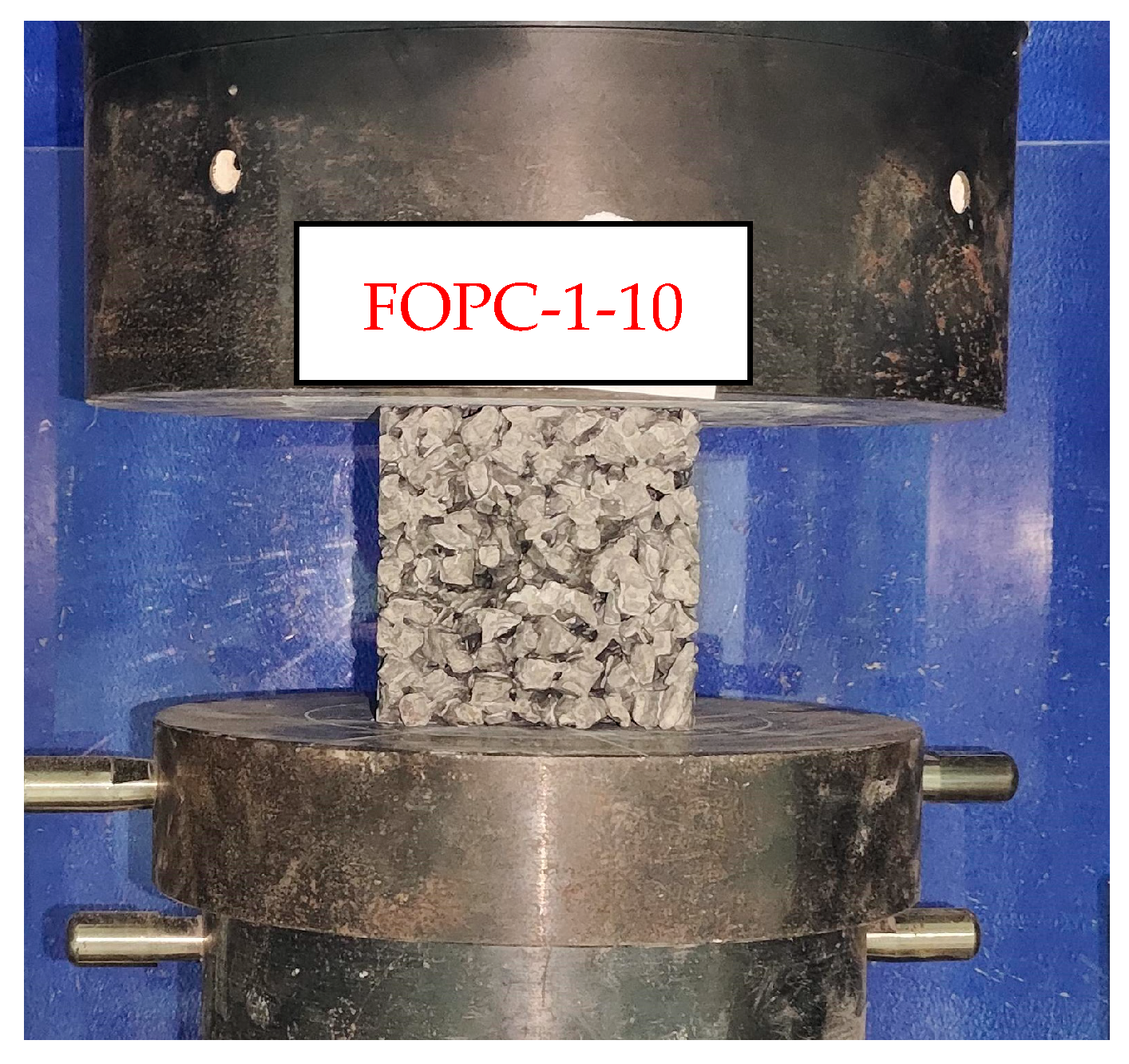


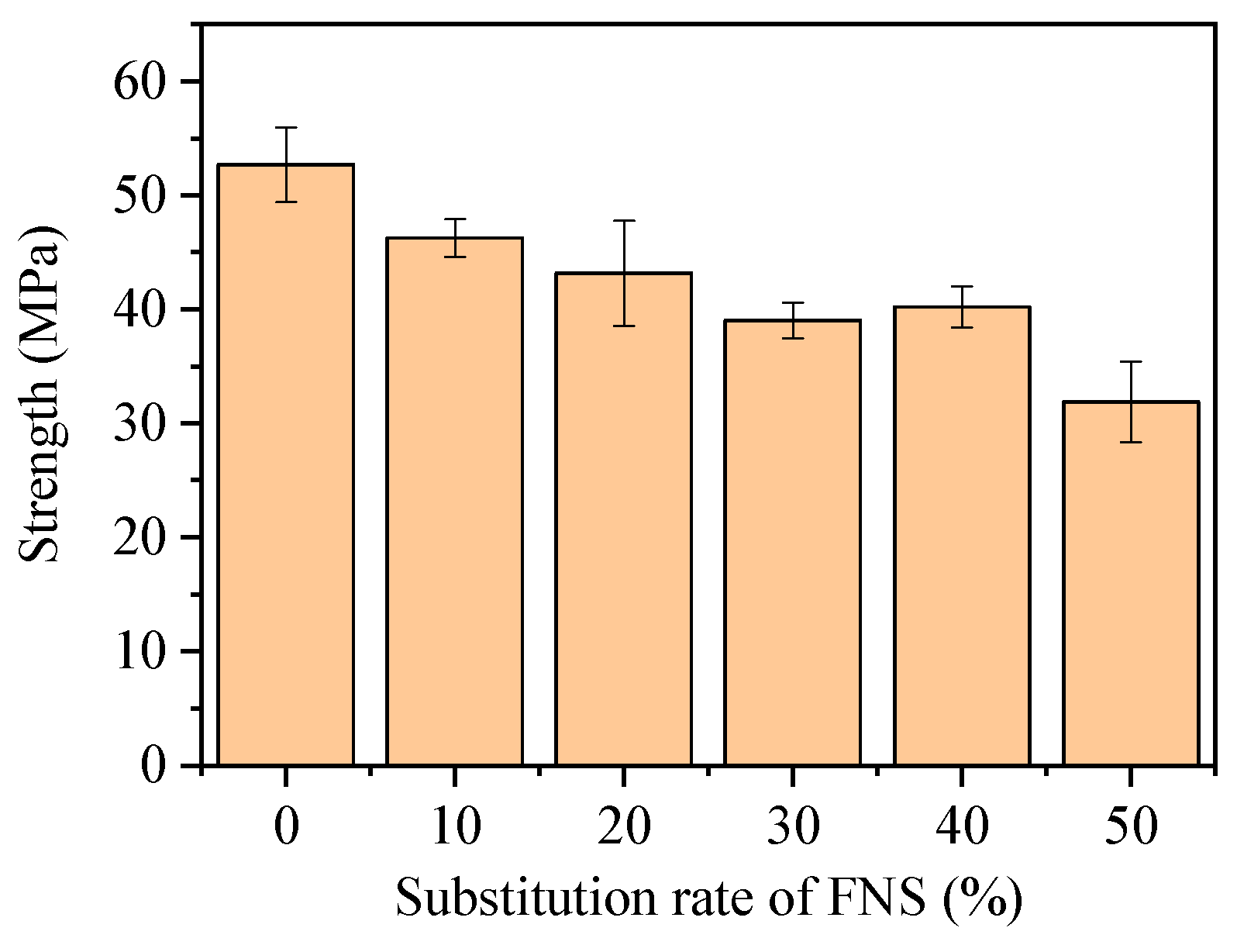
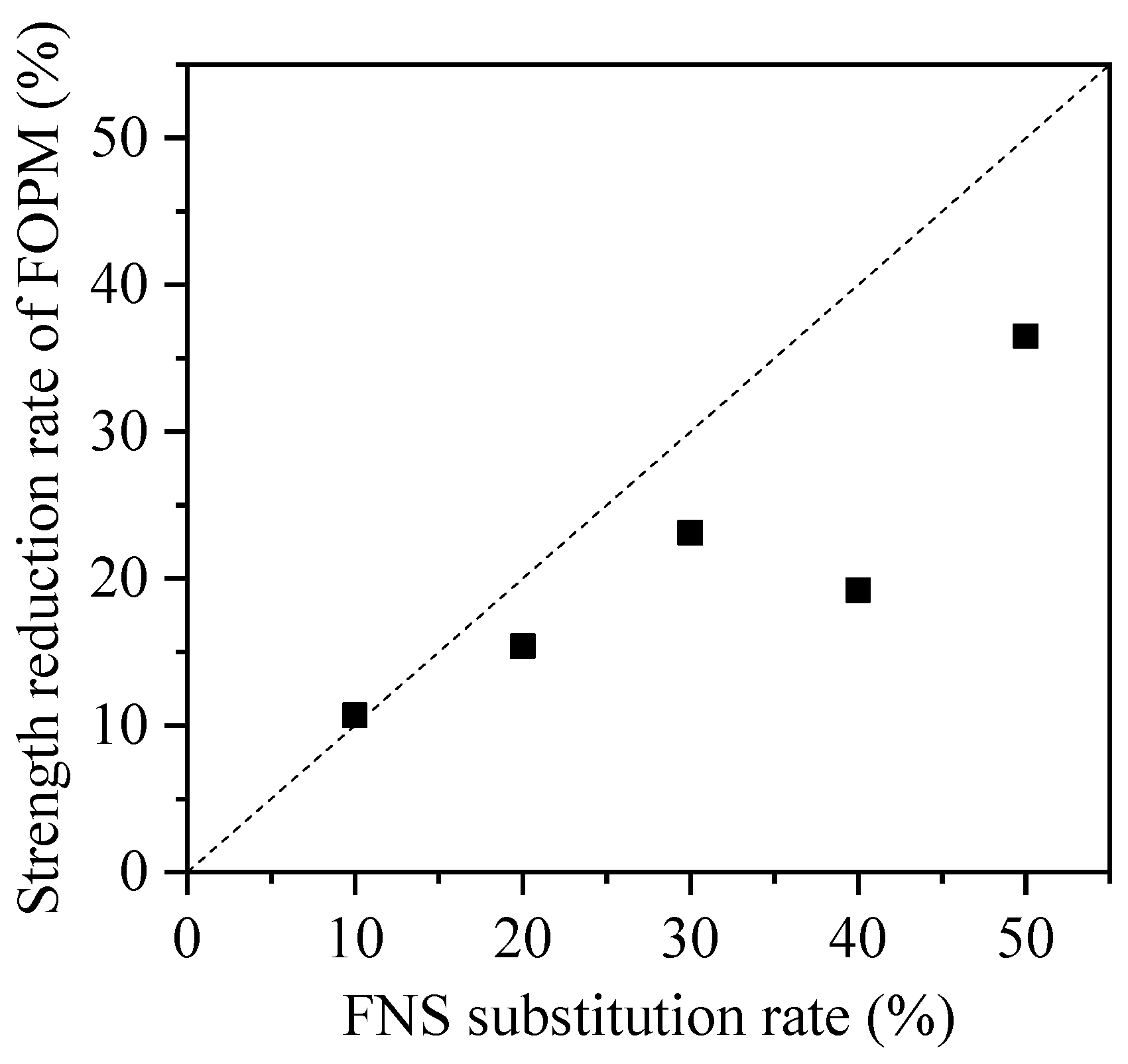
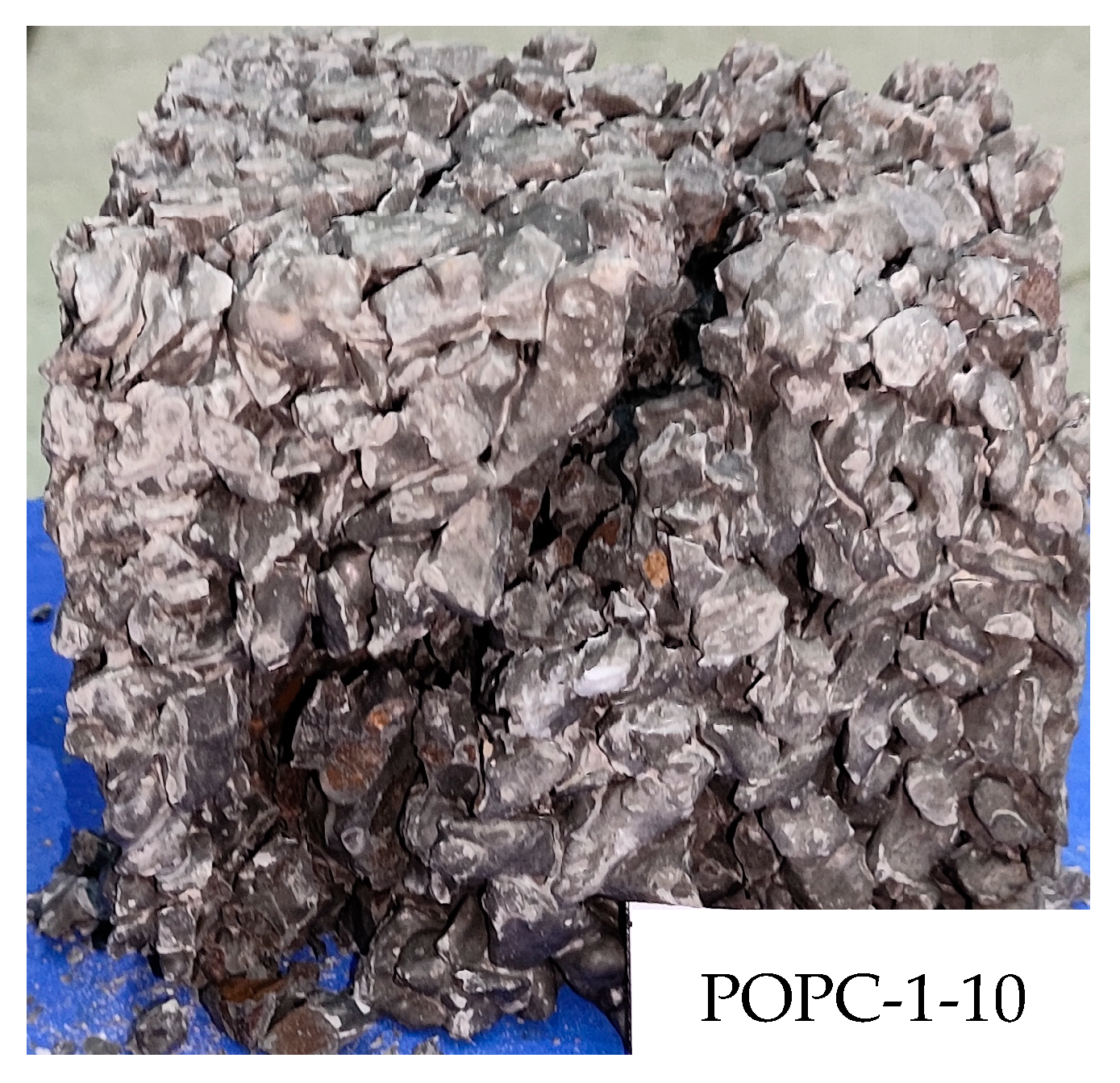
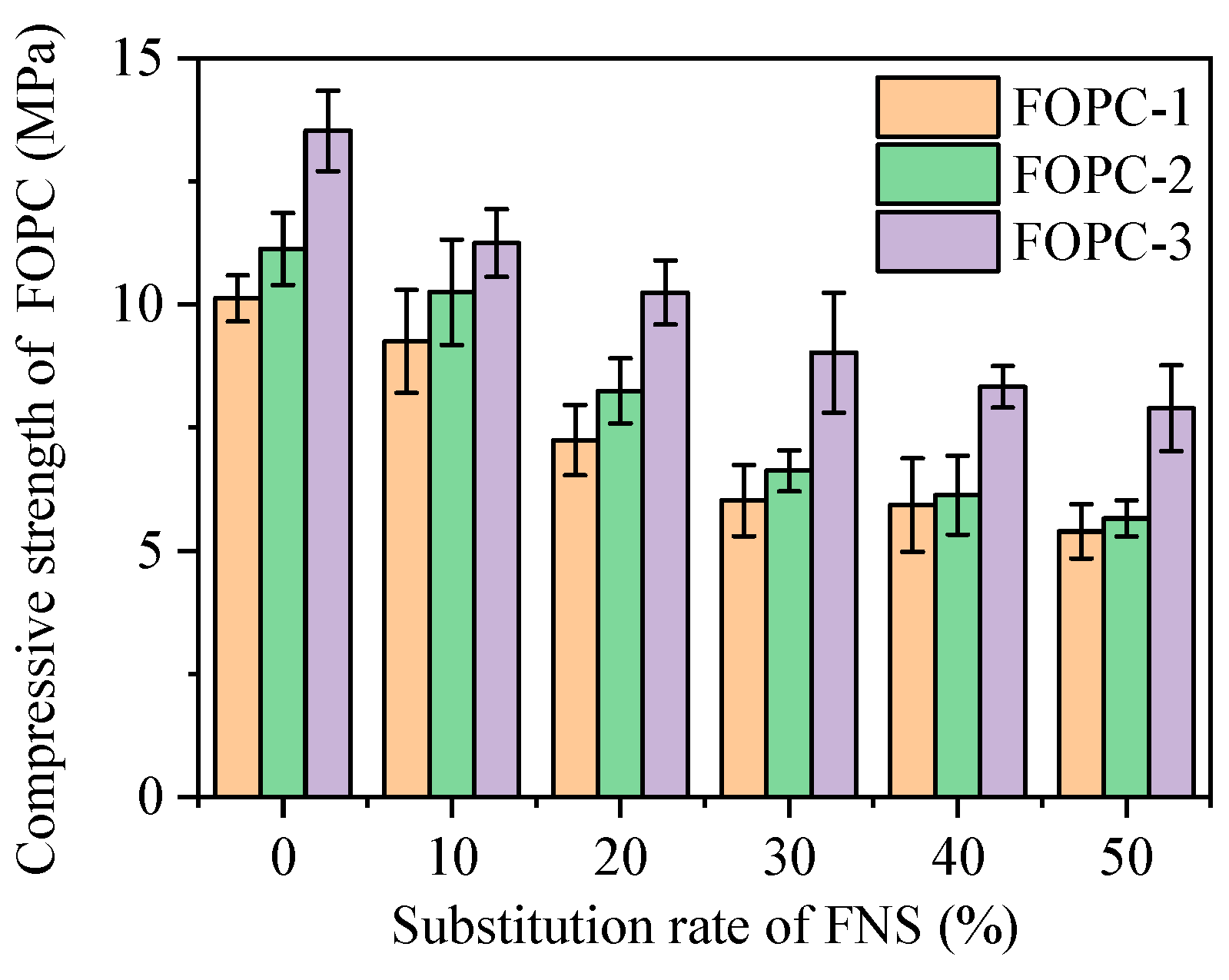

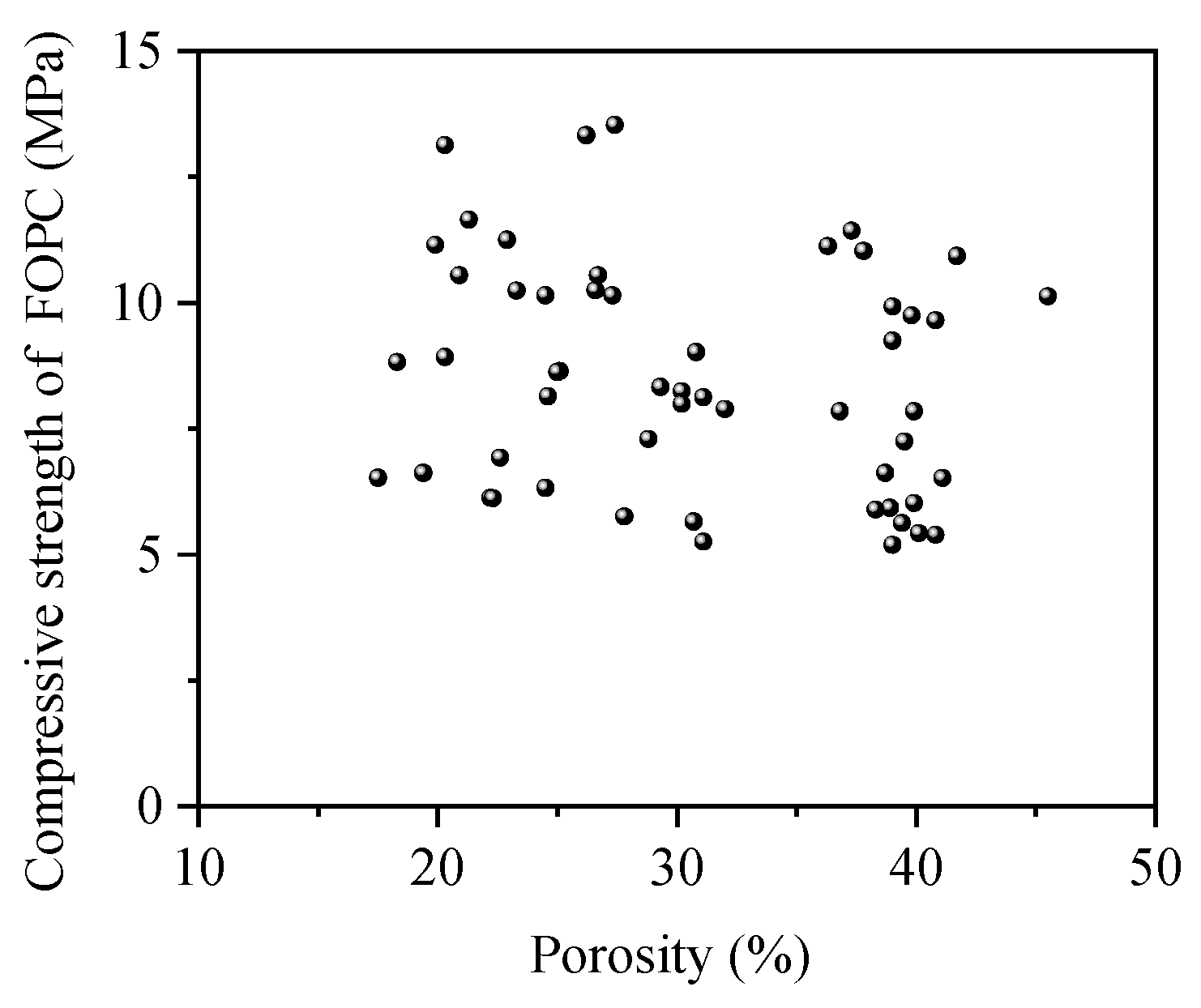
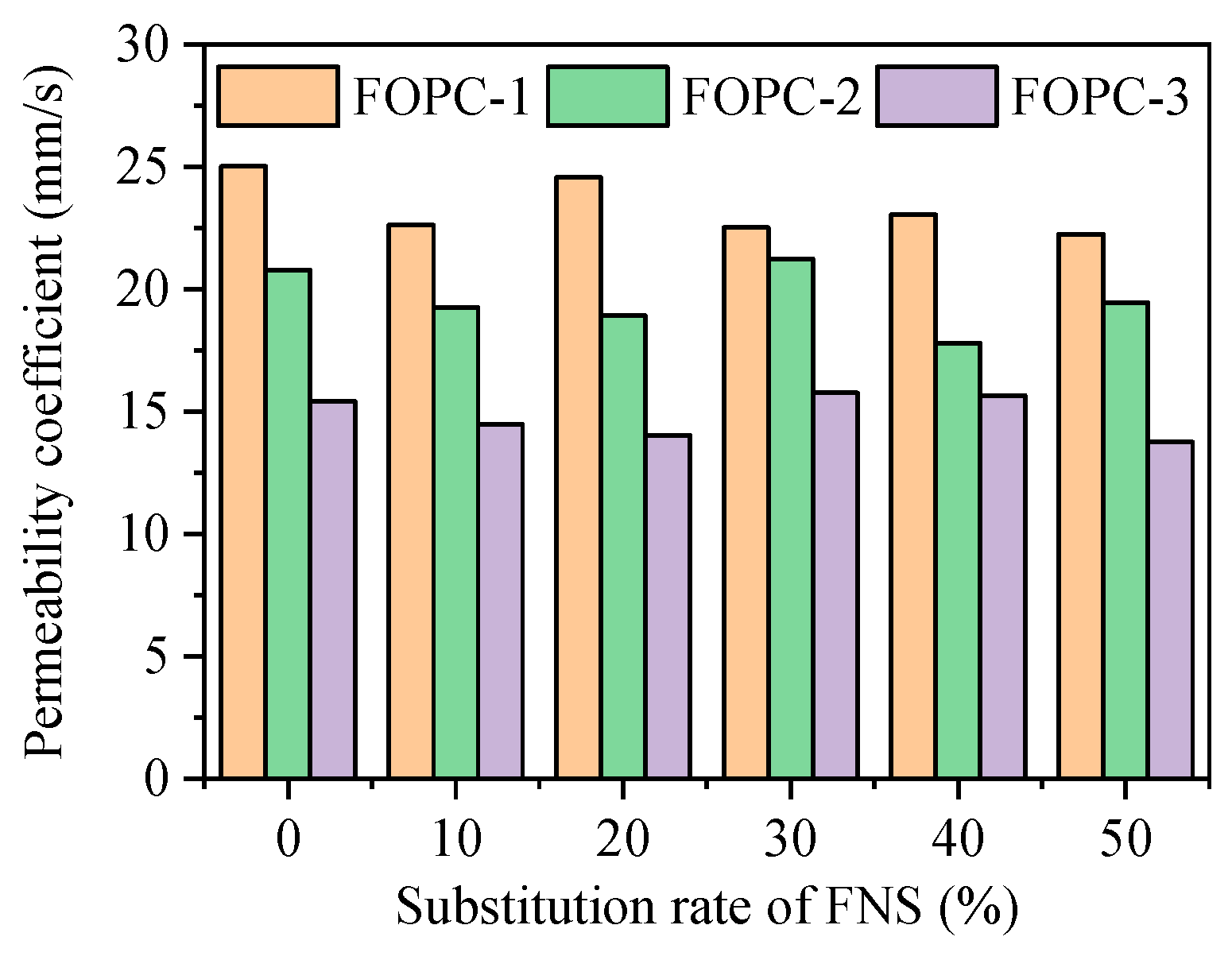

| Component | CaO | SiO2 | Al2O3 | MgO | SO3 | MnO | Others |
|---|---|---|---|---|---|---|---|
| % | 35.58 | 30.91 | 16.71 | 10.27 | 2.25 | 1.12 | 3.16 |
| Group | No. | Coarse Aggregate (kg) | Cementitious Material (kg) | Reinforcing Agent (kg) | Water (kg) | |
|---|---|---|---|---|---|---|
| OPC | FNS | |||||
| FOPC-1 | FOPC-1-0 | 1600 | 300 | 0 | 10 | 136 |
| FOPC-1-10 | 1600 | 270 | 30 | 10 | 136 | |
| FOPC-1-20 | 1600 | 240 | 60 | 10 | 136 | |
| FOPC-1-30 | 1600 | 210 | 90 | 10 | 136 | |
| FOPC-1-40 | 1600 | 180 | 120 | 10 | 136 | |
| FOPC-1-50 | 1600 | 150 | 150 | 10 | 136 | |
| FOPC-2 | FOPC-2-0 | 1600 | 320 | 0 | 12 | 144 |
| FOPC-2-10 | 1600 | 288 | 32 | 12 | 144 | |
| FOPC-2-20 | 1600 | 256 | 64 | 12 | 144 | |
| FOPC-2-30 | 1600 | 224 | 96 | 12 | 144 | |
| FOPC-2-40 | 1600 | 192 | 128 | 12 | 144 | |
| FOPC-2-50 | 1600 | 160 | 160 | 12 | 144 | |
| FOPC-3 | FOPC-3-0 | 1600 | 350 | 0 | 15 | 154 |
| FOPC-3-10 | 1600 | 315 | 35 | 15 | 154 | |
| FOPC-3-20 | 1600 | 280 | 70 | 15 | 154 | |
| FOPC-3-30 | 1600 | 245 | 105 | 15 | 154 | |
| FOPC-3-40 | 1600 | 210 | 140 | 15 | 154 | |
| FOPC-3-50 | 1600 | 175 | 175 | 15 | 154 | |
| No. | Cementitious Material (kg) | Water (kg) | |
|---|---|---|---|
| OPC | FNS | ||
| FOPM-0 | 300 | 0 | 136 |
| FOPM-10 | 270 | 30 | 136 |
| FOPM-20 | 240 | 60 | 136 |
| FOPM-30 | 210 | 90 | 136 |
| FOPM-40 | 180 | 120 | 136 |
| FOPM-50 | 150 | 150 | 136 |
Disclaimer/Publisher’s Note: The statements, opinions and data contained in all publications are solely those of the individual author(s) and contributor(s) and not of MDPI and/or the editor(s). MDPI and/or the editor(s) disclaim responsibility for any injury to people or property resulting from any ideas, methods, instructions or products referred to in the content. |
© 2024 by the authors. Licensee MDPI, Basel, Switzerland. This article is an open access article distributed under the terms and conditions of the Creative Commons Attribution (CC BY) license (https://creativecommons.org/licenses/by/4.0/).
Share and Cite
Tang, Z.; Peng, H.; Mei, P.; Huang, F.; Yi, S.; Feng, F. Performance Analysis of Ferronickel Slag-Ordinary Portland Cement Pervious Concrete. Materials 2024, 17, 1628. https://doi.org/10.3390/ma17071628
Tang Z, Peng H, Mei P, Huang F, Yi S, Feng F. Performance Analysis of Ferronickel Slag-Ordinary Portland Cement Pervious Concrete. Materials. 2024; 17(7):1628. https://doi.org/10.3390/ma17071628
Chicago/Turabian StyleTang, Zhongping, Hua Peng, Pingbo Mei, Fanglin Huang, Shixiang Yi, and Fan Feng. 2024. "Performance Analysis of Ferronickel Slag-Ordinary Portland Cement Pervious Concrete" Materials 17, no. 7: 1628. https://doi.org/10.3390/ma17071628






